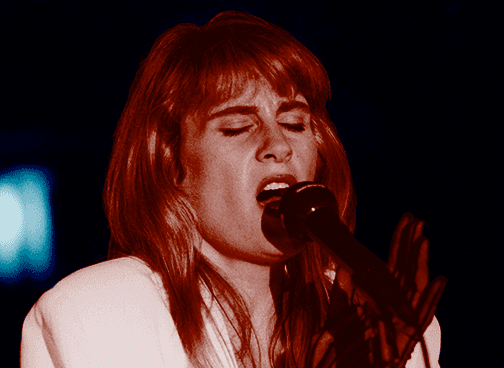Singer-Songwriter Nora York’s Influence Spreads With Release of Posthumous Albums
York, who died of pancreatic cancer shortly after her 60th birthday in 2016, was so gloriously pan-stylistic that she helped transform pan-stylism itself into a legitimate musical genre.

Nora York
‘Rain’
Good Mood Records
“Rain,” the newly released album by the late Nora York, reminds me that I always find myself being surprised that so-called singer-songwriters are now treated as a category of music unto themselves. When you go to the front page of the all-music guide, say, the “headline” this week, for the end of 2023, is listings of the best albums of the year: “Favorite Country Albums,” “Favorite R&B Albums,” and “Favorite Singer-Songwriter Albums.”
That makes sense, in that though the best singer-songwriters don’t sound anything like each other, they don’t easily fit into pre-set genres.
Joni Mitchell is a key player in the Laurel Canyon folk rock movement, but her best albums are pure jazz. Abbey Lincoln was a jazz singer whose originals had memorable hooks and lyric lines to rival those of the best pop songwriters. And even though I would also classify Tom Waits as very much a jazz artist — albeit one who had the good fortune to be marketed as rock-pop — it seems that this is largely a female phenomenon.
Nora York, who died of pancreatic cancer shortly after her 60th birthday in 2016, was so gloriously pan-stylistic that she helped transform pan-stylism itself into a legitimate musical genre. Somehow, “jazz” is the first adjective that usually gets attached to her name, but there’s as much folk, rock, and pop content in her work as there is in, say, that of Ms. Mitchell or Carole King. The new release also embraces subgenres from what is usually regarded as the classical music realm: opera, baroque, and chamber music.
York exerted an influence on her contemporaries — and subsequent generations — that’s in an inverse ratio to her very small output. Basically, her entire catalog is only five albums, two of which were released posthumously: “To Dream the World” (1995), “Alchemy” (1999), “What I Want” (2005), “Swoon” (2019), and “Rain” (2023). I don’t know if Nellie McKay (born 1982) or Kat Edmonson (1983) ever heard Nora York, but it’s easy to imagine them all being part of the same continuum.
York was the kind of unique, highly personal artist that writers like me like to call “quirky,” by which we probably mean that she refused to stay in any one lane, that she was constantly combining sounds that we never thought we would hear in the same project or even the same song.
The most recent two albums are both collaborations with the songwriter and producer Jamie Lawrence, and “Rain” is so ambitious and so far-reaching that it’s hardly surprising that it wasn’t finished until seven years after her death. York and Mr. Lawrence make a point to begin the album with a cliché, a song titled “Home is Where the Heart Is,” and end with one of the most famous pieces in the history of Western music, an adaptation of “When I am Laid in Earth,” by Henry Purcell, from “Dido and Aeneas” (circa 1688), one of the earliest operas that is still regularly performed.
That appears to be the strategy, to open and close with something very familiar, but the album itself is unstintingly original, and sounds like nothing else I’ve ever heard — there’s little like it even in York’s previous releases. Throughout “Rain,” York and Mr. Lawrence consistently build on and reference classical works, including Handel’s “Water Music” and Puccini’s “Tosca” in addition to Purcell.
As the title suggests, “Water Water Everywhere” uses “Rime of the Ancient Mariner,” the 1795 epic poem by Samuel Taylor Coleridge, as a point of departure. York might be said to “sample” classical music and poetry much the same way hip-hop artists sample 1960s soul jazz grooves.
The majority of the songs on “Rain” were originally composed for two musical theater works, one being a meditation on climate change also titled “Water Water Everywhere” and another called “Jump,” based on the “Tosca” story. The “Jump” songs in particular make brilliant use of classical voices: You hear two opera singers, bass-baritone Kevin Burdette and tenor Andrew Drost, performing in Italian in the background while York sings her original music and lyrics in English in the foreground.
At first, there were moments when I thought I was hearing two different performances playing randomly at the same time, i.e., one on Apple Music and the other on YouTube, but the more you listen, the more you realize that York and Mr. Lawrence have blended these disparate sounds together in a unique, brilliant mix: “Love and Beauty” suggests contemporary Euro pop, albeit completely acoustic and with a dramatic recitation in the middle, while “Love Only Me” sounds like Elizabethan bluegrass.
In addition to being a collaboration with Jamie Lawrence, “Rain” teams York with her brother, the bassoonist Andrew Schwartz. This is a double reed woodwind rarely heard outside of classical and symphonic music. Mr. Schwartz plays both behind and with her, sometimes like an accompanist, sometimes like a second voice or duet partner, sometimes like another character in the narrative.
Their most intimate performance together is the Purcell aria, which concludes the album on a note that is somehow both somber and life-affirming, especially when we remember that the artist herself didn’t live to hear the finished product, “Remember me, but ah! forget my fate.”

